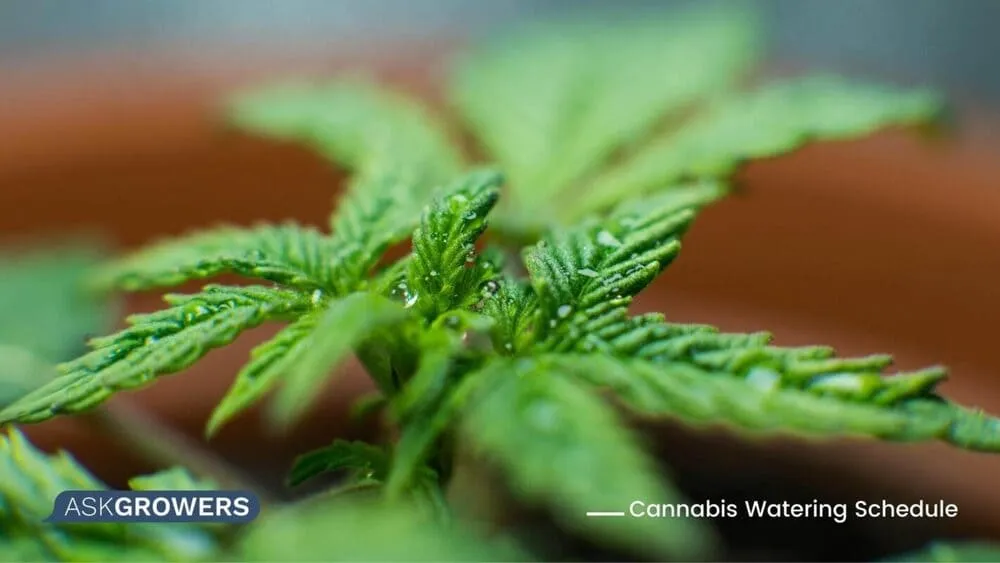Water is one of the resources no cannabis plant can survive without. It facilitates photosynthesis, enables the consumption of nutrients, and fills cell walls, making plants strong and healthy. Adequate water supply also ensures optimal cannabinoid content in buds, which is exactly what you are expecting. Researchers estimated that an average cannabis plant requires nearly 22.7 liters of water per day.
Amateur cannabis growers often think that watering is a no-brainer. You can water the plant when the soil becomes too dry or do it every day just in case. The more water, the better, right? However, this essential practice is much more complicated than one may think. You need to use common sense and a few watering tricks to avoid overwatering and supply just the right amount of water. This article will help you understand how much water your plants need depending on the changing environmental conditions.
Why Do I Need a Flexible Cannabis Watering Schedule?
The water needs of marijuana plants change all the time. As the plant grows, it requires a different amount of water to sustain life in its roots and leaves and enable flowering. However, there seems to be no consensus on the specific watering schedule. Some experts argue that you need to water the plants twice a day during the seedling stage and then switch to the once-a-day schedule during the vegetative stage. Watering your plants every two to three days is enough when they begin to flower. Others opt for less frequent watering (every three to seven days, depending on the growth stage).
To avoid confusion, examine your plant and soil closely every day to determine water needs. Don’t let the soil become too moist or too dry, and find the schedule that works for your environmental conditions and the growing medium.
Other factors that affect marijuana watering frequency include:
- Temperature
- Lighting
- Weather (for outdoor growing)
- Humidity
These factors alter all the time, meaning that the watering schedule should also be flexible.
There are also environmental concerns involved in developing a good watering schedule. The dwindling water resources are a pressing problem in many parts of the world, so the importance of preserving water hardly needs to be stated. Researchers have already raised concerns about the immense water requirements of cannabis production. Therefore, a carefully planned and efficient watering schedule may help minimize water use while at the same time providing cannabis plants with just the right amount of moisture. When used with other advanced growing methods, watering schedules may make cannabis cultivation greener.
Indoor Watering
The indoor watering schedule is more consistent because you fully control the growing environment. Humidity, temperature, and lighting remain stable throughout the growing cycle, so you don’t need to make any dramatic changes in watering. At the same time, your plants depend on your punctuality and diligence, as there is no backup for them if you forget to water them on time. This presents an additional challenge because you need to invest a lot of time.

So, what is a good watering schedule for indoor weed plant? The golden rule is to water marijuana plants every two to three days. Do this early in the morning when you turn the grow lights on. In this way, you will avoid mold development and allow the plants to absorb nutrients effectively throughout the lighting period.
What are the signs of over-watering marijuana plants? Pay attention to how fast the soil absorbs water. If it takes several minutes for the water to soak, it means that the soil is already too moist. Other symptoms of overwatering include:
- Slowed growth
- Mold
- Root diseases
- Swollen leaves
The problem is that excess water washes out all vital nutrients and does not allow cannabis plants to consume them. Therefore, you need to avoid providing too much water because it impedes aeration, nutrition intake, and plant growth. Conversely, water insufficiency often results in leaves discoloration, indicating that your plants do not receive essential nutrients.
Outdoor Watering
You need to remember that the watering schedule for flowering outdoor cannabis is different. Marijuana plants kept outdoors are exposed to different environmental conditions (e.g., extreme weather, temperature fluctuations) that affect water demands. For example, drying winds and high temperatures in summer increase the need for water. The soil quality also matters, as soils saturated with clay generally lead to poor drainage while sandy soils dry out too quickly.
You may need to water the garden every day or every four days, depending on the environmental conditions. Therefore, even though the watering schedule is still an excellent option to keep the plants healthy, do not stick to it rigidly. If you see that the soil has become very dry or notice wilding, you can water the plants ahead of schedule. Similarly, heavy rains may provide enough moisture for an extended period, eliminating the need to stick to the schedule.

You also need to know what time of day is best for watering outdoor marijuana. It is recommended to water plants early in the morning so that they have the whole day to soak up water and nutrients under the sunlight. Use a sprinkler or any other tool that allows delivering water gently into the soil. Using a hose with high water pressure is a bad idea, especially if the plants are still small and weak.
Try this simple trick if you follow the schedule but think that it is not enough. Stick a finger a few centimeters into the soil by about. Is the soil moist or dry? Adjust the schedule based on your findings.
Conclusion
As long as you stick to the watering schedule for weed plant and adjust it as needed, your plants will grow strong and healthy. If you struggle with remembering when to water the garden, keep a journal or set smartphone notifications. The former option is preferable because you can also write down practical observations (e.g., how fast the soil dries out). Keeping up with the schedule may seem overwhelming, but you get used to it quickly and can enjoy the fruits of your labor very soon.

